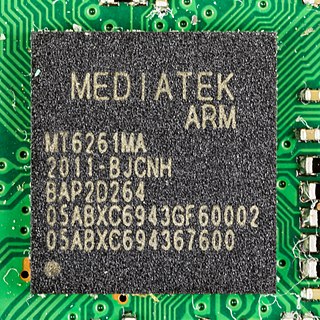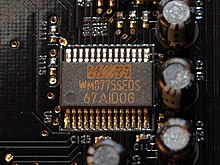
The iPod is a discontinued series of portable media players and multi-purpose mobile devices that were designed and marketed by Apple Inc. from 2001 to 2022. The first version was released on November 10, 2001, about 8+1⁄2 months after the Macintosh version of iTunes was released. Apple sold an estimated 450 million iPod products as of 2022. Apple discontinued the iPod product line on May 10, 2022. At over 20 years, the iPod brand is the longest-running to be discontinued by Apple.

A smartphone, often simply called a phone, is a mobile device that combines the functionality of a traditional mobile phone with advanced computing capabilities. It typically has a touchscreen interface, allowing users to access a wide range of applications and services, such as web browsing, email, and social media, as well as multimedia playback and streaming. Smartphones have built-in cameras, GPS navigation, and support for various communication methods, including voice calls, text messaging, and internet-based messaging apps.

A portable media player (PMP) or digital audio player (DAP) is a portable consumer electronics device capable of storing and playing digital media such as audio, images, and video files. The data is typically stored on a compact disc (CD), Digital Versatile Disc (DVD), Blu-ray Disc (BD), flash memory, microdrive, SD cards or hard disk drive; most earlier PMPs used physical media, but modern players mostly use flash memory. In contrast, analogue portable audio players play music from non-digital media that use analogue media, such as cassette tapes or vinyl records.

ARM7 is a group of 32-bit RISC ARM processor cores licensed by ARM Holdings for microcontroller use. The ARM7 core family consists of ARM700, ARM710, ARM7DI, ARM710a, ARM720T, ARM740T, ARM710T, ARM7TDMI, ARM7TDMI-S, ARM7EJ-S. The ARM7TDMI and ARM7TDMI-S were the most popular cores of the family.
Cirrus Logic Inc. is an American fabless semiconductor supplier that specializes in analog, mixed-signal, and audio DSP integrated circuits (ICs). Since 1998, the company's headquarters have been in Austin, Texas.
PortalPlayer, Inc., founded in 1999, was a fabless semiconductor company that supplied system-on-a-chip semiconductors, firmware and software for personal media players. The company handled semiconductor design and firmware development, while subcontracting the actual semiconductor manufacturing to merchant foundries.
Mobile music is music which can be transported, or in other words, mobile. The term itself is a bit ambiguous.

Zune was a brand of digital media products and services that was marketed by Microsoft from November 2006 until it was discontinued in June 2012. Zune consisted of a line of portable media players, a music subscription service known as Zune Music Pass plus Zune Marketplace for music, TV and movies, streaming services for the Xbox 360 game console, and the Zune software media player for Windows PCs which also acted as desktop sync software for Windows Phone.
The following comparison of portable media players compares general and technical information for notable digital playback devices.

ESS Technology Incorporated is a private manufacturer of computer multimedia products, Audio DACs and ADCs based in Fremont, California with R&D centers in Kelowna, British Columbia, Canada and Beijing, China. It was founded by Forrest Mozer in 1983. Robert L. Blair is the CEO and President of the company.
UNISOC, formerly Spreadtrum Communications, Inc., is a Chinese fabless semiconductor company headquartered in Shanghai which produces chipsets for mobile phones. UNISOC develops its business in two major fields - consumer electronics and industrial electronics. Consumer electronics includes smartphones, feature phones, smart audio systems, smart wearables and other related devices. Industrial electronics cover fields such as LAN IoT, WAN IoT and smart displays.

A dock connector is an electrical connector used to attach a mobile device simultaneously to multiple external resources. Dock connectors typically carry a variety of signals and power, through a single connector, to simplify the process of docking the device. A dock connector may be embedded in a mechanical fixture used to support or align the mobile device or may be at the end of a cable.

The iPhone is the first iPhone model and the first smartphone developed and marketed by Apple Inc. After years of rumors and speculation, it was officially announced on January 9, 2007, and was released in the United States on June 29, 2007.

The IEEE/RSE James Clerk Maxwell Medal is an award given by the IEEE and Royal Society of Edinburgh, UK. It is named after James Clerk Maxwell (1831–1879), who made fundamental contributions to the classical theory of electromagnetic radiation. The award is presented annually, and was established in 2006.

The iPhone 7 and iPhone 7 Plus are smartphones that were developed and marketed by Apple Inc. They are the tenth generation of the iPhone. They were announced on September 7, 2016, at the Bill Graham Civic Auditorium in San Francisco by Apple CEO Tim Cook, and were released on September 16, 2016, succeeding the iPhone 6, iPhone 6 Plus, iPhone 6S and iPhone 6S Plus as the flagship devices in the iPhone series. Apple also released the iPhone 7 and iPhone 7 Plus in numerous countries worldwide throughout September and October 2016. They were succeeded as flagship devices by the iPhone 8 and iPhone 8 Plus on September 12, 2017, and were discontinued with the announcement of the iPhone 11 and iPhone 11 Pro on September 10, 2019.
William Ewart John Farvis was a pioneering electronics engineer and educator. His war-time service was in electronic countermeasures. In his subsequent career at the University of Edinburgh he initiated the Department of Electrical Engineering, establishing its capabilities in silicon device processing and enhancing industrial interactions through Wolfson Microelectronics.

The iPhone 11 is a smartphone developed and marketed by Apple Inc. It is the thirteenth generation of iPhone, succeeding the iPhone XR, and was unveiled on September 10, 2019, alongside the higher-end iPhone 11 Pro at the Steve Jobs Theater in Apple Park, Cupertino, by Apple CEO Tim Cook. Preorders began on September 13, 2019, and the phone was officially released on September 20, 2019, one day after the official public release of iOS 13.
The iPhone's hardware is designed by Apple Inc. Apple directly sub-contracts hardware production to external OEM companies, maintaining a high degree of control over the end product.
Alastair David Milne is a Scottish technologist.













